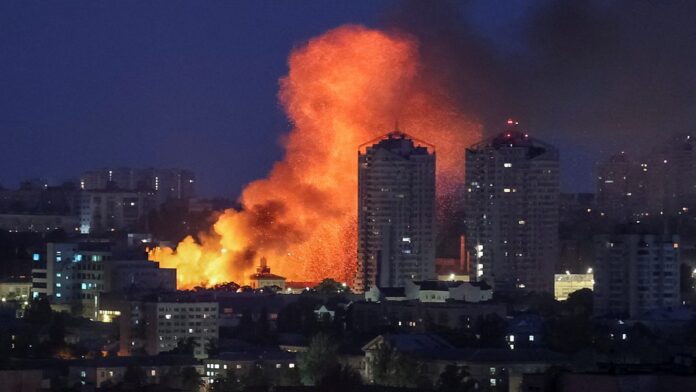Russia carried out one of its largest drone attacks recently, launching 324 drones and seven missiles at Ukrainian targets overnight between July 27 and 28. This intense assault led to at least four civilian deaths and left 40 injured, including children, marking a marked escalation in the ongoing aerial confrontations. Ukrainian air defenses managed to intercept most of the incoming threats — 309 drones and two cruise missiles out of the 331 fired. However, 15 drones and two missiles still hit three key locations, causing widespread damage and casualties.
Drone Assault Targets Kyiv and Strategic Military Sites
The capital Kyiv faced significant damage with a Russian drone hitting an apartment building in the Darnytskyi district. The strike wounded eight people, among them a three-year-old child. The impact shattered windows from the sixth to the eleventh floors and damaged parked vehicles. Kyiv’s police and bomb disposal teams are investigating the scene, documenting it as another war crime committed by the aggressors.
Strategically, the Russian assault aimed at the Starokostiantyniv air base in Khmelnytskyi Oblast, housing Ukraine’s 7th Tactical Aviation Brigade. This base is reportedly considered to host future F-16 fighter jets supplied by Western allies. The attack employed 324 Shahed-type drones launched from various directions inside Russia, supported by four Kh-101 cruise missiles and three Kinzhal hypersonic missiles. Notably, the three Kinzhal missiles failed to reach their targets.
Ukrainian Air Defense Holds Firm Amid Escalation

Ukraine’s air defense forces delivered strong resistance, intercepting the vast majority of the barrage. This included shooting down 309 drones and two cruise missiles, showcasing the growing effectiveness of Ukrainian defenses against Russia’s drone warfare tactics. President Volodymyr Zelenskyy highlighted these defenses’ success and emphasized ongoing efforts to close the funding gap for drone production, signaling readiness to boost capabilities with international help.
The scale of the attack also triggered a NATO response, with allied fighters, including Sweden’s JAS 39 Gripen jets based in Poland, scrambled to patrol the region. Additionally, a Russian drone crossed into Lithuanian airspace from Belarus, further heightening tensions and prompting a search operation.
Personal Analysis: Marking a Shift in Air Warfare Dynamics
This massive overnight bombardment highlights a shift in Russia’s strategy, relying heavily on large drone swarms to overwhelm Ukrainian defenses. Though most drones were intercepted, the persistent use of such large-scale attacks stresses Ukraine’s air defense systems and puts civilians at increasing risk. The targeting of both civilian areas and strategic military sites points to a dual approach aimed at damaging Ukraine’s military capabilities while terrorizing the population.
At the same time, Ukraine’s improved interception rate reflects advancements in its air defense technology and tactics. The international support, including proposed delivery of advanced fighter jets and financial aid for drone production, will be crucial for Kyiv’s resilience. However, the attack underscores the ongoing high human cost and challenges in ending the conflict, as peace negotiations face repeated setbacks. The involvement of NATO forces in defensive patrols signals the conflict’s broader geopolitical risks and the delicate balance of regional security.
Sources: cnn.com

